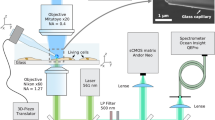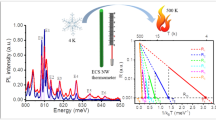Abstract
Sensitive probing of temperature variations on nanometre scales is an outstanding challenge in many areas of modern science and technology1. In particular, a thermometer capable of subdegree temperature resolution over a large range of temperatures as well as integration within a living system could provide a powerful new tool in many areas of biological, physical and chemical research. Possibilities range from the temperature-induced control of gene expression2,3,4,5 and tumour metabolism6 to the cell-selective treatment of disease7,8 and the study of heat dissipation in integrated circuits1. By combining local light-induced heat sources with sensitive nanoscale thermometry, it may also be possible to engineer biological processes at the subcellular level2,3,4,5. Here we demonstrate a new approach to nanoscale thermometry that uses coherent manipulation of the electronic spin associated with nitrogen–vacancy colour centres in diamond. Our technique makes it possible to detect temperature variations as small as 1.8 mK (a sensitivity of 9 mK Hz−1/2) in an ultrapure bulk diamond sample. Using nitrogen–vacancy centres in diamond nanocrystals (nanodiamonds), we directly measure the local thermal environment on length scales as short as 200 nanometres. Finally, by introducing both nanodiamonds and gold nanoparticles into a single human embryonic fibroblast, we demonstrate temperature-gradient control and mapping at the subcellular level, enabling unique potential applications in life sciences.
This is a preview of subscription content, access via your institution
Access options
Subscribe to this journal
Receive 51 print issues and online access
$199.00 per year
only $3.90 per issue
Buy this article
- Purchase on Springer Link
- Instant access to full article PDF
Prices may be subject to local taxes which are calculated during checkout




Similar content being viewed by others
References
Yue, Y. & Wang, X. Nanoscale thermal probing. Nano Rev. http://dx.doi.org/10.3402/nano.v3i0.11586 (2012)
Lucchetta, E., Lee, J., Fu, L., Patel, N. & Ismagilov, R. Dynamics of Drosophila embryonic patterning network perturbed in space and time using microfluidics. Nature 434, 1134–1138 (2005)
Kumar, S. V. & Wigge, P. A. H2A.Z-containing nucleosomes mediate the thermosensory response in Arabidopsis. Cell 140, 136–147 (2010)
Lauschke, V. M., Tsiairis, C. D., François, P. & Aulehla, A. Scaling of embryonic patterning based on phase-gradient encoding. Nature 493, 101–105 (2012)
Kamei, Y. et al. Infrared laser-mediated gene induction in targeted single cells in vivo. Nature Methods 6, 79–81 (2009)
Vreugdenburg, T., Willis, C., Mundy, L. & Hiller, J. A systematic review of elastography, electrical impedance scanning, and digital infrared thermography for breast cancer screening and diagnosis. Breast Cancer Res. Treat. 137, 665–676 (2013)
Schroeder, A. et al. Treating metastatic cancer with nanotechnology. Nature Rev. Cancer 12, 39–50 (2011)
O’Neal, D. P., Hirsch, L. R., Halas, N. J., Payne, J. D. & West, J. L. Photo-thermal tumor ablation in mice using near infrared-absorbing nanoparticles. Cancer Lett. 209, 171–176 (2004)
Majumdar, A. Scanning thermal microscopy. Annu. Rev. Mater. Sci. 29, 505–585 (1999)
Kim, S. H. et al. Micro-Raman thermometry for measuring the temperature distribution inside the microchannel of a polymerase chain reaction chip. J. Micromech. Microeng. 16, 526 (2006)
Yang, J., Yang, H. & Lin, L. Quantum dot nano thermometers reveal heterogeneous local thermogenesis in living cells. ACS Nano 5, 5067–5071 (2011)
Vetrone, F. et al. Temperature sensing using fluorescent nanothermometers. ACS Nano 4, 3254–3258 (2010)
Okabe, K. et al. Intracellular temperature mapping with a fluorescent polymeric thermometer and fluorescence lifetime imaging microscopy. Nature Commun. 3, 705 (2012)
Donner, J., Thompson, S., Kreuzer, M., Baffou, G. & Quidant, R. Mapping intracellular temperature using green fluorescent protein. Nano Lett. 12, 2107–2111 (2012)
Shalek, A. K. et al. Vertical silicon nanowires as a universal platform for delivering biomolecules into living cells. Proc. Natl Acad. Sci. USA 107, 1870–1875 (2010)
Acosta, V. et al. Temperature dependence of the nitrogen-vacancy magnetic resonance in diamond. Phys. Rev. Lett. 104, 070801 (2010)
Toyli, D. et al. Measurement and control of single nitrogen-vacancy center spins above 600 K. Phys. Rev. X 2, 031001 (2012)
Chen, X.-D. et al. Temperature dependent energy level shifts of nitrogen-vacancy centers in diamond. Appl. Phys. Lett. 99, 161903–161903 (2011)
Taylor, J. et al. High-sensitivity diamond magnetometer with nanoscale resolution. Nature Phys. 4, 810–816 (2008)
Jin, C., Li, Z., Williams, R., Lee, K. & Park, I. Localized temperature and chemical reaction control in nanoscale space by nanowire array. Nano Lett. 11, 4818–4825 (2011)
Maze, J. et al. Nanoscale magnetic sensing with an individual electronic spin in diamond. Nature 455, 644–647 (2008)
Balasubramanian, G. et al. Nanoscale imaging magnetometry with diamond spins under ambient conditions. Nature 455, 648–651 (2008)
Hodges, J. et al. Time keeping with electron spin states in diamond. Phys. Rev. A 87, 032118 (2013)
Balasubramanian, G. et al. Ultralong spin coherence time in isotopically engineered diamond. Nature Mater. 8, 383–387 (2009)
Dolde, F. et al. Electric-field sensing using single diamond spins. Nature Phys. 7, 459–463 (2011)
Maurer, P. et al. Far-field optical imaging and manipulation of individual spins with nanoscale resolution. Nature Phys. 6, 912–918 (2010)
Xu, G. et al. Identification of proteins sensitive to thermal stress in human neuroblastoma and glioma cell lines. PLoS ONE 7, e49021 (2012)
Helmchen, F. & Denk, W. Deep tissue two-photon microscopy. Nature Methods 2, 932–940 (2005)
Wee, T.-L. et al. Two-photon excited fluorescence of nitrogen-vacancy centers in proton-irradiated type Ib diamond. J. Phys. Chem. A 111, 9379–9386 (2007)
Tsoli, M. et al. Activation of thermogenesis in brown adipose tissue and dysregulated lipid metabolism associated with cancer cachexia in mice. Cancer Res. 72, 4372–4382 (2012)
Acknowledgements
We thank R. Walsworth, V. Denic, C. Latta, L. Jiang, A. Gorshkov, P. Cappellaro, A. Sushkov and I. Lovchinsky for discussions and help with experiments. This work was supported by the NSF, the Center for Ultracold Atoms, the Defense Advanced Research Projects Agency (QUASAR programme), the Army Research Office (MURI programme), the Packard Foundation, NIH Pioneer Awards (5DP1OD003893-03), the NHGRI (1P50HG006193-01) and the Swiss National Science Foundation (PBSKP2_143918) (P.C.M.).
Author information
Authors and Affiliations
Contributions
P.C.M., H.J.N., H.P. and M.D.L. developed the idea for the study. G.K., P.C.M. and N.Y.Y. designed and conducted the experiments and analysed the data. M.K., P.K.L. and H.P. prepared the biological samples. All authors participated in discussions and writing of the manuscript.
Corresponding authors
Ethics declarations
Competing interests
The authors declare no competing financial interests.
Supplementary information
Supplementary Information
This file contains Supplementary Text, Supplementary Figures 1-5 and Supplementary References. (PDF 259 kb)
Rights and permissions
About this article
Cite this article
Kucsko, G., Maurer, P., Yao, N. et al. Nanometre-scale thermometry in a living cell. Nature 500, 54–58 (2013). https://doi.org/10.1038/nature12373
Received:
Accepted:
Published:
Issue Date:
DOI: https://doi.org/10.1038/nature12373
This article is cited by
-
Nanodiamonds enable femtosecond-processed ultrathin glass as a hybrid quantum sensor
Scientific Reports (2023)
-
Nanoscale thermal control of a single living cell enabled by diamond heater-thermometer
Scientific Reports (2023)
-
In situ electron paramagnetic resonance spectroscopy using single nanodiamond sensors
Nature Communications (2023)
-
Quantum sensors for biomedical applications
Nature Reviews Physics (2023)
-
Self-optimized single-nanowire photoluminescence thermometry
Light: Science & Applications (2023)
Comments
By submitting a comment you agree to abide by our Terms and Community Guidelines. If you find something abusive or that does not comply with our terms or guidelines please flag it as inappropriate.



